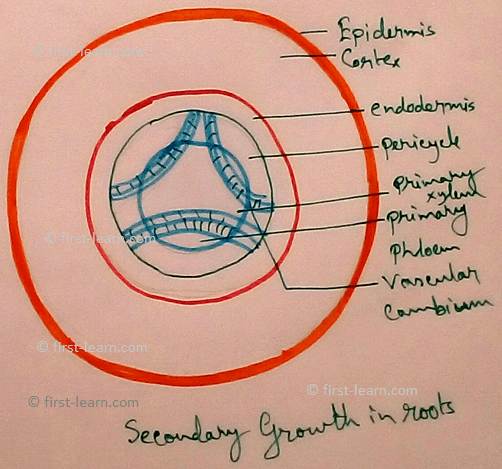Secondary Growth of Roots
Secondary growth is observed in vascular cambium and phellogen of dicot roots. It is seen that vascular cambium can be formed secondarily from conjunctive parenchyma and part of pericycle just lying opposite to the protoxylem points. Initially vascular cambium is seems to be wavy but later on it becomes circular and vascular cambium is derived from pericycle, which is form primary vascular rays. At some other places it forms secondary xylem on the inner side and secondary phloem on the outside. Secondary vascular rays are observed in different places whereas primary vascular rays are multiseriate at the beginning and uniseriate on later.
Secondary phloem do not persist as a result when it is become operational the previous phloem get crushed before it becomes operational. Secondary xylem and on the other hand primary xylem both are persist.
Annual rings are not present, because the areas where the roots of the plants grow are, very less variations of temperature of soil (due to less variations of season) are observed.
Cork cambium or phellogen are formed from pericycle which produces phellem or cork on the outside and on the other hand secondary cortex or phelloderm on the inner side. These three are together called periderm. In this case cortex and epiblema peel off, cork or phellem is made of dead cells. Lenticular are observed in different places.
Anomalous secondary growth of roots-
In some plants storage roots are observed where accessory cambial rings are formed which cut out less or little secondary xylem and more storage parenchyma in secondary phloem. Example- Beet, sweet potato.
1. What do you mean by primary xylem and secondary xylem?
Primary xylem is derived from procambium during primary growth and is consists of protoxylem and metaxylem.
Secondary xylem is formed from vascular cambium during secondary growth.
2. What do you mean by primary phloem and secondary phloem?
Primary phloem is formed from procambium during primary growth. It may or may be not show differentiation into protophloem and metaphloem.
Secondary phloem is produced during the secondary growth of vascular cambium.
From Secondary Growth of Roots to HOME PAGE
Recent Articles
-
Explain about Growth in Plants |Definition of Growth & Differentiation
Feb 27, 25 02:07 PM
Growth is a permanent increase in length or volume of an organism that brought upon by an increase in its dimensions due to synthesis of new protoplasmic material. -
Definition of Respiratory Quotient | calculation | Application | Plant
Dec 02, 24 12:09 AM
Definition of respiration quotient- the ratio of the carbon-dioxide evolved to that of the oxygen consumed by a cell, tissue, plants or animals in a given time is called respiratory quotient. It is us… -
Amphibolic Pathway | Definition | Examples | Pentose Phosphate Pathway
Jun 06, 24 10:40 AM
Definition of amphibolic pathway- Amphibolic pathway is a biochemical pathway where anabolism and catabolism are both combined together. Examples of amphibolic pathway- there are different biochemical… -
Respiratory Balance Sheet | TCA Cycle | ATP Consumption Process
Feb 18, 24 01:56 PM
The major component that produced during the photosynthesis is Glucose which is further metabolised by the different metabolic pathways like glycolysis, Krebs cycle, TCA cycle and produces energy whic… -
Electron Transport System and Oxidative Phosphorylation | ETC |Diagram
Feb 04, 24 01:57 PM
It is also called ETC. Electron transfer means the process where one electron relocates from one atom to the other atom. Definition of electron transport chain - The biological process where a chains…





New! Comments
Have your say about what you just read! Leave me a comment in the box below.